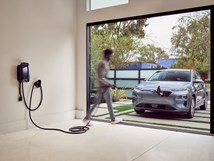Continental Addresses the Challenges of Automated Driving
And those challenges aren’t all sensor- and algorithm-based, either.
Jeff Klei, president of Continental North America (continental.com), doesn’t mince words. There are some 40,000 fatalities on U.S. roads each year and more than 90 percent of those are caused by human error. And as a supplier of technology to the auto industry, Klei and his colleagues around the world (accidents don’t just happen in the U.S., not by a long shot: according to the World Health Organization, more than 1.25-million people die each year as a result of road traffic injuries) are committed to developing the hardware and the software that will achieve what they call “Vision Zero.”
That’s as in zero fatalities. Zero injuries. Zero accidents. Presumably, if you can achieve the latter, the first two fall into place.
Klei doesn’t pretend that this is going to be something that happens suddenly. Rather, he says that it is going to be an evolutionary process. Technologies will evolve to provide the means by which more and more aspects of the driving process will be automated, thereby reducing the number of accidents. And it will be necessary for consumer awareness and acceptance of these various technologies to increase, as well.
This latter may prove more challenging than you might think.
That is, Continental conducted surveys in both 2013 and 2018.
In 2013 66 percent of the respondents responded in the positive to the proposal “Automated driving scares me somewhat.” The same year, 50 percent agreed “I don’t believe it will function properly.”
So here we have 66 and 50 percent, respectively, of people who are scared and/or skeptical.
Not good.
But what happened in 2018, after companies ranging from General Motors to Waymo to Ford and others have made what are unquestionably giant strides in developing and even deploying automated driving?
Things got worse.
As for the number scared, it rose from 66 to 77 percent.
And as for the skeptics, their number increased from 50 percent to 77 percent.
So, it isn’t going to just be a matter for technological developments. There are also perceptual issues that must be addressed.
Continental is developing the technologies that will incrementally lead to a no-accidents environment. Technologies such as V2X, which is based on a small ECU, sensors that most new vehicles are already equipped with, and an antenna for connection to the outside world. Through either cellular or DSRC (dedicated short-range communications) a vehicle can communicate with both other vehicles and infrastructure (e.g., intersections are being equipped with cameras so that things not visible to a driver can be communicated to the vehicle on a real-time basis) to even a system that combines fluid and air to clean the surfaces of cameras and other sensors to assure that they can do their jobs as required.
They are enhancing existing technologies, such as improving the resolution of wheel speed sensors from >2 cm to <1 cm, which is required for things like automated parking (i.e., it is important to know, with confident accuracy, where the exterior surfaces of a vehicle are in order to slip it into a parking space). And while on the subject of automated parking, while existing systems use ultrasound sensors in order to determine where a parking space is available, Continental has developed a system that uses 12 ultrasonic sensors and four fish-eye cameras with the result being that the automated parking system (which can be operated outside the vehicle via a smartphone) can park in places where there are no other vehicles around (which is necessary for ultrasonic-only situations: the sound waves need something to bounce off of) can work when there are simply lines painted on the road surface.
Continental has a small autonomous transport—CubE, or Continental Urban mobility Experience—running in its parking lot in its Auburn Hills facility to ferry people that uses radar, lidar, cameras, and an NVIDIA-based computing platform that processes the sensor data and drives the vehicle accordingly. It is probably the least scary vehicle you’ll ever ride in.
Ibro Muharemovic is the head of engineering systems for ADAS (advanced driver assistance systems) at Continental North America. He recalls that when he and his colleagues started developing an intelligent rear view camera system back in 2011—which has become a single aluminum, laser welded box that about a cubic inch in size that contains both a fish-eye lens camera and a processor that detects and classifies objects when the vehicle is in reverse that can be integrated with the braking system such that if an object is detected, the driver will not only be audibly and visibly warned, but the brakes can be applied to prevent an accident—they read accident reports from various police agencies, including that in Auburn Hills, where Continental North America is headquartered. “It was depressing,” Muharemovic recalls, citing heart-rending situations when someone backed over their toddler. Systems like the one they developed can help reduce the chances of things like that happening.
“Vision Zero” isn’t just a catchy marketing term. For the people at Continental, it is very real. And very important.
RELATED CONTENT
-
Plastics: The Tortoise and the Hare
Plastic may not be in the news as much as some automotive materials these days, but its gram-by-gram assimilation could accelerate dramatically.
-
Cobots: 14 Things You Need to Know
What jobs do cobots do well? How is a cobot programmed? What’s the ROI? We asked these questions and more to four of the leading suppliers of cobots.
-
on lots of electric trucks. . .Grand Highlander. . .atomically analyzing additive. . .geometric designs. . .Dodge Hornet. . .
EVs slowdown. . .Ram’s latest in electricity. . .the Grand Highlander is. . .additive at the atomic level. . .advanced—and retro—designs. . .the Dodge Hornet. . .Rimac in reverse. . .


.jpg;width=70;height=70;mode=crop)






